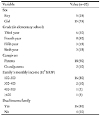References
1. Lee YS, Lim HS, Ahn HS, Chang NS. Nutrition throughout the life cycle 2rd edth ed. Seoul: Kyomunsa; 2005. p. 219–220.
2. Lee YJ, Lee MJ, Lee SM. Nutrition Education 1st edth ed. Seoul: Shinkwang; 2013. p. 5–6.
3. Park BK, Cho MS. Taste education reduces food neophobia and increases willingness to try novel foods in school children. Nutr Res Pract 2016;10(2):221–228.
4. Korea Health Industry Development Institute. National Food & Nutrition Statistics I: Based on 2017 Korea National Health and Nutrition Examination Survey Cheongju: Health & Nutrition Survey, Health Technology Administration Complex; 2018.
5. Korea Health Industry Development Institute. National Food & Nutrition Statistics I: Based on 2016 Korea National Health and Nutrition Examination Survey Cheongju: Health & Nutrition Survey, Health Technology Administration Complex; 2017.
6. Korea Health Industry Development Institute. National Food & Nutrition Statistics 2013: Based on 2013 Korea National Health and Nutrition Examination Survey Cheongju: Health & Nutrition Survey, Health Technology Administration Complex; 2013.
7. Johnson F, Wardle J, Griffith I. The adolescent food habits checklist: reliability and validity of a measure of healthy eating behavior in adolescents. Eur J Clin Nutr 2002;56(7):644–649.
8. American Dietetic Association. Dietitians of Canada. Position of the American dietetic association and Dietitians of Canada: vegetarian diets. J Am Diet Assoc 2003;103(6):748–765.
9. The Korean Nutrition Society. Dietary Reference Intakes for Koreans 2015 Seoul: The Editorial Department of the Korean Nutrition Society; 2015. p. 964–966.
10. Vereecken C, Pedersen TP, Ojala K, Krolner R, Dzielska A, Ahluwalia N, et al. Fruit and vegetable consumption trends among adolescents from 2002 to 2010 in 33 countries. Eur J Public Health 2015;25Suppl 2. :16–19.
12. Liquori T, Koch PD, Contento IR, Castle J. The cookshop program: outcome evaluation of a nutrition education program linking lunchroom food experiences with classroom cooking experiences. J Nutr Educ 1998;30(5):302–313.
13. Reverdy C, Chesnel F, Schlich P, Köster E, Lange C. Effect of sensory education on willingness to taste novel food in children. Appetite 2008;51(1):156–165.
14. Mustonen S, Rantanen R, Tuorila H. Effect of sensory education on school children's food perception: a 2-year follow-up study. Food Qual Prefer 2009;20(3):230–240.
15. Mustonen S, Tuorila H. Sensory education decreases food neophobia score and encourages trying unfamiliar foods in 8–12-year-old children. Food Qual Prefer 2010;21(4):353–360.
16. Hoppu U, Prinz M, Ojansivu P, Laaksonen O, Sandell MA. Impact of sensory-based food education in kindergarten on willingness to eat vegetables and berries. Food Nutr Res 2015;59:28795.
17. Shin HS. Montessori: Theory and practice for individualized education Paju: Yangseowon; 2007.
18. Woo T, Lee KH. Development of a sensory education textbook and teaching guidebook for preference improvement toward traditional Korean foods in schoolchildren. Korean J Nutr 2011;44(4):303–311.
19. McAfee O. Cooking and eating with children: A way to learn Washington: Association for Children Education International; 1974.
20. Korea Food Education Network. Master Plan for Food Education (15-19) Seoul: Korea Food Education Network; 2014.
21. Kim JM. The effect of cooking activities on the unbalanced diet of young children [dissertation] Seoul: Ewha Women's University; 2003. Korean.
22. Kim YH. Evaluation of ‘Veggiecation’ program to promote vegetable intake of children: applying the theory of planned behavior [dissertation] Cheongju: Chungbuk National University; 2015. Korean.
23. Kratt P, Reynolds K, Shewchuk R. The role of availability as a moderator of family fruit and vegetable consumption. Health Educ Behav 2000;27(4):471–482.
24. Heath P, Houston-Price C, Kennedy OB. Increasing food familiarity without the tears. A role for visual exposure. Appetite 2011;57(3):832–838.
25. Bandura A. Health promotion by social cognitive means. Health Educ Behav 2004;31(2):143–164.
26. Contento IR. Nutrition education: Linking research, theory, and practice 2nd edth ed. Massachusetts: Jones and Bartlett Publishers; 2011.
27. Kim HJ. Development and evaluation of nutrition education program for prevention of unbalanced diet of elementary school students [dissertation] Daegu: Kyungpook National University; 2007. Korean.
28. Choo JH, Chung KM. Effect of direct and indirect visual exposure to increase Toddlers' vegetable eating. Korean J Health Psychol 2013;18(4):687–708.
29. Lee SJ, Jung KM. Effect of an exposure program to vegetables to increase young children's vegetable consumption. Korean J Health Psychol 2015;20(2):425–444.
30. Lynn F, Mercedes S. Get your family eating right-A 30-day plan for teaching your kids healthy eating habits for life 1st edth ed. Beverly: Fair Winds Press; 2013.
31. Cho HS, Kim MH, Choi MK. A study on vegetable intakes and dietary habits of middle school students in chungnam. Korean J Community Nutr 2010;15(4):525–535.
32. Lee MH. Study on increasing vegetable intake changing by cooking methods for school student at the school food service [dissertation] Yongin: Dankook University; 2011. Korean.
33. Kim EH. Studies on preference and consumption frequency of vegetables for school meals in higher-graders at elementary Schools in Incheon [dissertation] Incheon: Inha University; 2014. Korean.
34. Kim HY, Kwon S, Lee JS, Choi YS, Chung HR, Kwak TK, et al. Development of a Nutrition Quotient (NQ) equation modeling for children and the evaluation of its construct validity. Korean J Nutr 2012;45(4):390–399.
35. Park JH. Vegetable intake status of elementary school students in Gwangju area [dissertation] Seoul: Kyung Hee University; 2014. Korean.
36. Choi JY. Intake of vegetables of elementary school students in urban and rural Areas [dissertation] Daegu: Keimyung University; 2011. Korean.







